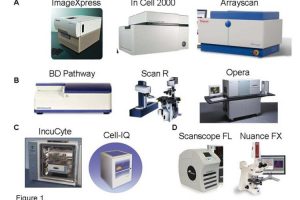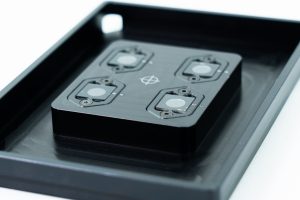Quality control of HCS-HTS fluorescence imaging systems
Solution for performance assessment and monitoring ReadIn the landscape of high-content screening (HCS) and high-throughput screening (HTS) fluorescence imaging systems, precision and reliability take center stage. The staggering amount of data generated by HCS-HTS fluorescence imaging systems necessitates meticulous assessment and monitoring. Ensuring the reliability, consistency, and meaningful utilization of the colossal datasets becomes imperative for accurate analysis.
We explore the critical role of quality control in this dynamic environment and introduce Argolight’s innovative solutions to monitor and optimize fluorescence HCS imaging system performance. Join us on this journey through the landscape of quality control and solutions shaping the field.
High-content screening, alternatively referred to as high-content analysis, merges automated cellular imaging with advanced image analysis for extracting comprehensive multi-parametric data at the individual cell level.
Initially conceived as a supplementary approach to conventional biochemical high-throughput screening (HTS) in drug discovery, high-content screening has evolved to find application across a wider spectrum within the life sciences. HCS and HTS are complementary approaches.
Where high-content provides many measurable quantities in a single image and rich information content, high-throughput, with a high-rate, provides many images for long experimental runs.
HCS now stands as an impartial and quantitative imaging technique for evaluating cellular behavior and function. Both HTS and HCS are used within fields of life sciences such as phenotyping, virology, drug discovery.
Many manufacturers offer a range of high-content imaging systems, you’ll find a non-comprehensive list at the bottom of this article.
“Another important factor in lead discovery efforts is the quality of the process. This is particularly important for screening, which deals with very large data sets because only assays of high statistical quality can be used for proper data analysis.”
The future of High-Throughput screening
L. M. MAYR and P. FUERST, Journal of Biomolecular Screening 13(6); 2008; DOI: 10.1177/1087057108319644 .
Argolight’s Innovation: A Holistic Solution for Optimal Performance
Argolight is introducing an innovation — a comprehensive hardware and software duo engineered to evaluate and monitor the optical performance of HCS-HTS fluorescence imaging systems. This innovative solution seamlessly integrates into the quality control processes of these devices, ensuring optimal functionality—think reliability, consistency, and the meaningful use of the colossal data these systems churn out.
1. The Crucial Role of Quality Control
It is nowadays recognized by the microscopist community and microscope manufacturers that quality control (QC) and performance assessment of fluorescence imaging systems are critical issues that need to be addressed. This rings especially true for HCS-HTS fluorescence imaging systems, which produce a staggering amount of data after rigorous efforts in sample preparation, imaging, and analysis. Think millions of images, each capturing a dynamic experiment with numerous variables at play.
“The images taken with HCS need to have very consistent imaging conditions and that’s why it makes it very dependent on the consistent quality of the imaging. Ultimately, you want to take images of a large number of samples and compare them to each other. The technical variances have to be minimized, with whatever one can do to ensure consistent illumination, that the imaging quality does not change over time, at least within a single acquisition.”
A high-content screening platform in Switzerland
HCS-HTS relies on automated image acquisition and analysis of cells in culture. It provides information such as the number of cells, the distribution of a target protein in each cell, the morphological features, or the co-localization between different objects.

Image courtesy of Neil Carragher
As any microscope introduces a bias, it is important to measure it, to prevent the misinterpretation of the results, wrong conclusions, and non-reproducible research. Besides, as HCS-HTS imaging campaigns can last for days, weeks, or even months, periodic quality controls during the campaign are recommended, to ensure the system performance has not fluctuated and the generated data are consistent.
Quality control is even more important than machine learning. It is coming into the game, helping laboratories to extract intelligence quickly out of large volumes of data.
“The lack of standardized data validation and quality assurance processes has been recognized as one of the major hurdles for successful implementing high-throughput experimental technologies (Kaul, 2005). Therefore, automated quality assessment and data correction systems need to be applied to biochemical data in order to recognize and eliminate experimental artefacts that might confound with important biological or chemical effects.”
An efficient method for the detection and elimination of systematic error in high-throughput screening, V. Makarenkov et al., Bioinformatics, Volume 23, Issue 13, July 2007, doi:10.1093/bioinformatics/btm145

2. Argolight’s Toolbox: Argo-Well Plate and Daybook Software
Having perceived the significance of this issue, Argolight has developed a new solution, consisting of the Argo-Well Plate (Argo-WP) hardware and the Daybook software. This dynamic duo aims to:
- Validate a system at its origin time (preferably post-installation or maintenance, when the system performance is likely to be reliable).
- Assess and monitor the system’s performance over time.
- Detect any malfunctions hindering proper system use.
Typical applications?
The Argo-WP enables researchers to know the difference between two systems’ performance.
-
- Facilitate joint research with laboratories worldwide by making it possible to compare results.
- Share samples between labs.
You can know if the data you get out of your system are trustworthy.
-
- Pre-analysis of your system to enable successful acquisition of dataset and prevent artifacts.
- Reduce the cost and time of acquiring a bad dataset. Get it right the first time!
- Speed of data acquisition is crucial. Do not waste time with corrupted data.
- Make bioassays robust and trustable.
- Make sure that datasets are fit for artificial intelligence analysis.
- Feed Public data repositories with valid data.
“If we have the ability to make good predictions at a certain fork in the road, it would actually be transformed into the 5 % success rate of pharma R&D. Machine learning is actually the right tool if we have the ability to feed the algorithms with high quality data, because machine learning is only as good as the data that you feed it.”
Machine Learning: New approach to Drug Discovery, by Daphne Koller, Insitro

You can keep track of performance of your system performance over time and manage easily your data quality.
-
- Build regulatory files with clear and quantified info.
- Manage risk.
- Prove your Good Laboratory Practice (GLP).
- Strengthen your funding requests.
Practical example?
Monitoring the performance of an HCS-HTS Yokogawa CellVoyager CV7000 fluorescence imaging system for over a year. The results, in terms of field uniformity, underscore the tool’s potential. See the example.
The QC plate contains long-term fluorescent patterns with sub-micrometer feature sizes in 2D and 3D inside glass, on an aluminum carrier featuring a 96 well-plate with format and dimensions as specified in the ANSI SLAS 1 to 4 – 2004 (R2012) standards. It is composed of four pieces of Argoglass of the 3rd generation, located at the same positions as the wells C5, C8, F5, and F8 of a standard plate, in which the following fluorescent patterns are embedded, respectively: a field of rings, a grid, a 4×4 intensity gradation, and 3D crossing stairs.
An article, written by Argolight CSO, presenting the solution has recently been published in Imaging and Microscopy. Read the full article below.
In a world of evolving microscopy, notably the trend of moving from qualitative to quantitative imaging, Argolight’s innovative toolbox offers a beacon of reliability, ensuring the seamless functioning of fluorescence imaging systems and unlocking the full potential of generated data. Stay tuned for more updates as we continue to illuminate the path of progress in quality control for HCS-HTS systems.

APPENDIX
- Some of the HCS-HTS imaging systems manufacturers
- Interesting bibliography
Statistical Analysis of Systematic Errors in High-Throughput Screening
High throughput microscopy: from raw images to discoveries, 2007
High content screening: a powerful approach to systems cell biology and drug discovery
Quality Control of Quantitative High Throughput Screening Data
Workflow and Metrics for Image Quality Control in Large-Scale High-Content Screens
User case: Kyoto University x Argolight – Fluorescent proteins observation
Matsuda Lab, Graduate School of Biostudies/Graduate School of Medicine, Kyoto University Introducing Argolight slides - A New Quality Control...
Precision Partners: Innopsys and Argolight on the InnoQuant Slide Scanners
In the intricate realm of pathology, drug discovery, and advanced research in brain function, cancer, and stem cells, the role of slide scanners has...
Lordil Microscopy announces the first quality control service using Argolight products.
Lordil Microscopy (lordil.fr) announces the first quality control service using Argolight products. This innovative service is offered through a...


